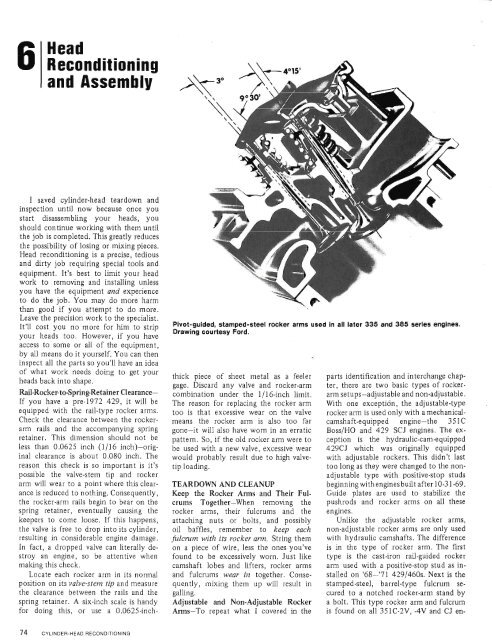How To Rebuild Your Ford V-8 351C-351M-400-429-460.pdf - Index of
How To Rebuild Your Ford V-8 351C-351M-400-429-460.pdf - Index of
How To Rebuild Your Ford V-8 351C-351M-400-429-460.pdf - Index of
Create successful ePaper yourself
Turn your PDF publications into a flip-book with our unique Google optimized e-Paper software.
1 and Assembly<br />
I saved cylinder-head teardown and<br />
inspection until now because once you<br />
start disassembling your heads, you<br />
should continue working with them until<br />
the job is completed. This greatly reduces<br />
the possibility <strong>of</strong> losing or mixing pieces.<br />
Head reconditioning is a precise, tedious<br />
and dirty job requiring special tools and<br />
equipment. It's best to limit your head<br />
work to removing and installing unless<br />
you have the equipment and experience<br />
to do the job. You may do more harm<br />
than good if you attempt to do more.<br />
Leave the precision work to the specialist.<br />
It'll cost you no more for him to strip<br />
your heads too. <strong>How</strong>ever, if you have<br />
access to some or all <strong>of</strong> the equipment,<br />
by all means do it yourself. You can then<br />
inspect all the parts so you'll have an idea<br />
<strong>of</strong> what work needs doing to get your<br />
heads back into shape.<br />
Rail-Rocker-toSpringRetainer Clearance-<br />
If you have a pre-1972 <strong>429</strong>, it will be<br />
equipped with the rail-type rocker arms.<br />
Check the clearance between the rockerarm<br />
rails and the accompanying spring<br />
retainer. This dimension should not be<br />
less than 0.0625 inch (1/I 6 inch)-original<br />
clearance is about 0.080 inch. The<br />
reason this check is so important is it's<br />
possible the valve-stem tip and rocker<br />
arm will wear to a point where this clearance<br />
is reduced to nothing. Consequently,<br />
the rocker-arm rails bean to bear on the<br />
spring retainer, eventually causing the<br />
keepers to come loose. If this happens,<br />
the valve is free to drop into its cylinder,<br />
resulting in considerable engine damage.<br />
In fact, a dropped valve can literally destroy<br />
an engine, so be attentive when<br />
making this check.<br />
Locate each rocker arm in its normal<br />
position on its valve-stem tip and measure<br />
the clearance between the rails and the<br />
spring retainer. A six-inch scale is handy<br />
for doing this, or use a 0.0625-inch-<br />
Pivot-guided, stamped-steel rocker arms used in all lator 335 and 385 series engines.<br />
Drawing courtesy <strong>Ford</strong>.<br />
thck piece <strong>of</strong> sheet metal as a feeler<br />
gage. Discard any valve and rocker-arm<br />
combination under the 1116-inch limit.<br />
The reason for replacing the rocker arm<br />
too is that excessive wear on the valve<br />
means the rocker arm is also too far<br />
gone-it will also have worn in an erratic<br />
pattern. So, if the old rocker arm were to<br />
be used with a new valve, excessive wear<br />
would probably result due to high valvetip<br />
loading.<br />
TEARDOWN AND CLEANUP<br />
Keep the Rocker Arms and Their Fulcrums<br />
<strong>To</strong>gether-When removing the<br />
rocker arms, their fulcrums and the<br />
attaching nuts or bolts, and possibly<br />
oil baffles, remember to keep each<br />
fulcnim with its rocker am. String them<br />
on a piece <strong>of</strong> wire, less the ones you've<br />
found to be excessively worn. Just like<br />
camshaft lobes and lifters, rocker arms<br />
and fulcrums wear in together. Consequently,<br />
mixing them up will result in<br />
galling.<br />
Adjustable and Non-Adjustable Rocker<br />
Arm-<strong>To</strong> repeat what I covered in the<br />
parts identification and interchange chapter,<br />
there are two basic types <strong>of</strong> rockerarm<br />
setups-adjustable and non-adjustable.<br />
With one exceptidn, the adjustable-type<br />
rocker arm is used only with a mechanicalcamshaft-equipped<br />
engine-the 35 1 C<br />
Boss/HO and <strong>429</strong> SCJ engines. The exception<br />
is the hydraulic-cam-equipped<br />
<strong>429</strong>CJ which was originally equipped<br />
with adjustable rockers. This didn't last<br />
too long as they were changed to the nonadjustable<br />
type with positive-stop studs<br />
beginning withenginesbuilt after 10-3 1-69.<br />
Guide plates are used to stabilize the<br />
pushrods and rocker arms on all these<br />
engines.<br />
Unlike the adjustable rocker arms,<br />
non-adjustable rocker arms are only used<br />
with hydraulic camshafts. The difference<br />
is in the type <strong>of</strong> rocker arm. The first<br />
type is the cast-iron rail-guided rocker<br />
arm used with a positive-stop stud as installed<br />
on '68-71 <strong>429</strong>1460s. Next is the<br />
stamped-steel, barrel-type fulcrum secured<br />
to a notched rocker-arm stand by<br />
a bolt. This type rocker arm and fulcrum<br />
is found on all <strong>351C</strong>-2V, -4V and CJ en-
















